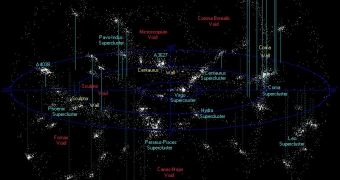An alternative proposal to the dark energy theory is currently gaining a strong foothold in the astronomical community, even though it contradicts one of the most fundamental principles of this discipline, namely that Earth's position in the Universe is not special, and that we are situated in a solar system like any other. The new theory states that we are located near the center of a massive void, an area of the Universe with a matter density far lower than that of matter outside the edges of the void.
In other words, the rate at which we now know the Universe is expanding might not be a question of time, as in how many light-years it has across, but a matter of space, as the concentration of matter outside the void we are supposedly located in is far greater than inside the bubble.
“More than about a decade ago, the fundamental parameters that describe the Universe on the largest scales, such as the expansion rate and the amount of spatial curvature, were only known with poor accuracy. Since then, precision measurements of the CMB by satellite and massive automated sky surveys on the ground have revolutionized cosmology by pinning those parameters down with high precision,” post-doctoral fellow Jim Zibin, from the University of British Columbia, told PhysOrg.
“It seemed very surprising to us that cosmological models such as the void models, which are so drastically different from standard dark energy models, could still fit all of this precision data,” he added, in a recent edition of the journal Physical Review Letters.
“Our study addresses one of the greatest mysteries in cosmology today – the apparent acceleration of the Universe's expansion. The standard explanation, dark energy, is itself so puzzling that researchers have tried hard to find viable alternatives, but with very few successes. Our study shows that it is extremely unlikely that one such alternative, void models, can be made to work. This strengthens the case that the acceleration is real and is due to dark energy,” Zibin explained.
He and colleague Adam Moss argue that the confirmation of a void theory could mean that a large part of the astronomy knowledge we've accumulated thus far is a lie, and would require a total rethinking of the plan of the Universe itself. They add that it's far more likely to believe in dark energy, even though evidence of its actual existence is scarce. However, this shouldn't be a reason for some to look for answers in twisted theories, they conclude.

 14 DAY TRIAL //
14 DAY TRIAL //